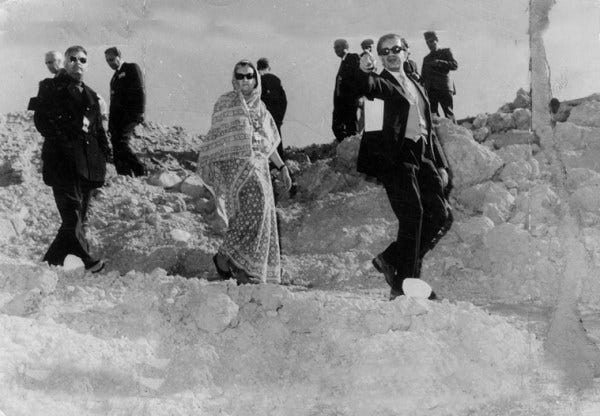From "Smiling Buddha" to "Operation Shakti"
A Comparative Analysis of India's Nuclear Tests from the 1974 Indira Gandhi era to Vajpayee in 1998.
From "Smiling Buddha" to "Operation Shakti"
After we published our article about the Pokhran blast on 18 May 1974, marking its golden jubilee, we have been inundated with requests from our readers asking how it differed from the nuclear tests carried out during the tenure of Prime Minister Atal Bihari Vajpayee in 1998. Here's a detailed comparison between the two landmark events.
Operation Shakti: Defining a New Era
The "Operation Shakti" nuclear tests, conducted in May 1998, were a bold and decisive move under Prime Minister Atal Bihari Vajpayee's leadership. On 11 May 1998, India detonated three nuclear devices, followed by two more on 13 May 1998, at the Pokhran Test Range in Rajasthan. These tests included both fission and thermonuclear devices, demonstrating a significant leap in India's nuclear capabilities. The timing of the tests was crucial, coming shortly after India had declared its intent to revise its strategic posture in the face of regional security challenges.
Vajpayee's second tenure— commencing 19th March, 1998— marked a 13-month period of assertive policy-making, and the tests were conducted with elaborate measures to evade international surveillance, reflecting meticulous planning and strategic foresight. The successful execution of "Operation Shakti" not only established India's advanced nuclear technology but also underscored its resolve to maintain strategic autonomy in a rapidly changing geopolitical landscape.
Context and Motivation
1974 "Smiling Buddha":
Peaceful Nuclear Explosion (PNE): India portrayed the 1974 test as a peaceful nuclear explosion intended for scientific and industrial purposes.
Security Concerns: Although the test had clear implications for national security, it was officially described as peaceful, partly to mitigate international backlash.
Geopolitical Climate: Conducted during the Cold War, with the immediate context of China's nuclear test in 1964 and India's conflicts with China and Pakistan.
1998 "Operation Shakti":
Explicit Weaponisation: The 1998 tests were unambiguously aimed at establishing India as a nuclear weapons state.
Security Doctrine: The tests were conducted in response to regional security dynamics, particularly nuclear developments in Pakistan and China's ongoing nuclear capabilities.
End of Cold War: The geopolitical landscape had changed significantly, with new regional threats and a more multipolar world order.
Scale and Scope
1974 "Smiling Buddha":
Single Test: Only one device was detonated, with an estimated yield of 8-12 kilotons.
Limited Scope: Focused on demonstrating basic nuclear capability.
1998 "Operation Shakti":
Series of Tests: Five nuclear devices were detonated over two days (11 and 13 May 1998). These included both fission and thermonuclear devices.
Advanced Capabilities: Demonstrated a range of nuclear capabilities, including a thermonuclear bomb, indicating significant technological advancements since 1974.
Secrecy and Planning
1974 "Smiling Buddha":
High Secrecy: The test was planned and executed with extreme secrecy to avoid detection by international intelligence agencies.
Internal Coordination: Limited to a small group of scientists and military officials.
1998 "Operation Shakti":
Strategic Secrecy: Despite being planned in secrecy, the operation involved a larger group of military and scientific personnel, and there were elaborate measures to evade satellite surveillance.
Political Decision: The tests were a strategic decision involving the highest levels of government, including the Prime Minister and the Cabinet Committee on Security.
International Reactions
1974 "Smiling Buddha":
Mixed Reactions: Initial global shock followed by a mix of criticism and restrained responses. India faced diplomatic censure and some sanctions but avoided a comprehensive international backlash.
Sanctions: Limited sanctions were imposed, particularly by Canada and the United States, but India managed to maintain many of its international relationships.
1998 "Operation Shakti":
Widespread Condemnation: Immediate and widespread international condemnation, including from the United Nations Security Council.
Economic Sanctions: Severe economic sanctions were imposed by several countries, including the United States and Japan. These sanctions targeted India's economy, technological transfers, and military supplies.
Strategic Dialogue: The tests led to a strategic dialogue with the United States, culminating in the Indo-US Civil Nuclear Agreement in 2005, which helped India reintegrate into the global nuclear community.
Domestic Reactions
1974 "Smiling Buddha":
National Pride: The test was a source of national pride and celebrated as a scientific achievement.
Political Unity: Broad political support within India, though some concerns about the potential arms race and economic impact were raised.
1998 "Operation Shakti":
Widespread National Support: The tests were hailed as a bold assertion of India's sovereignty and strategic autonomy.
Political and Public Consensus: There was a strong political consensus and public support for the tests, viewed as necessary for national security.
Long-Term Impact
1974 "Smiling Buddha":
Foundation for Future Development: Laid the groundwork for India's future nuclear weapons programme.
Non-Proliferation Stance: India's position on the NPT was solidified, viewing the treaty as discriminatory.
1998 "Operation Shakti":
Declared Nuclear State: India explicitly declared itself a nuclear weapons state, shaping its defence and foreign policy.
Nuclear Doctrine: Led to the formulation of India's nuclear doctrine, including a no-first-use policy and a credible minimum deterrent strategy.
Regional Arms Race: Prompted a series of nuclear tests by Pakistan, escalating the nuclear arms race in South Asia.
Geopolitical and Technological Advancement
The 1998 nuclear tests under Prime Minister Vajpayee were a significant escalation from the 1974 test in terms of scale, technological advancement, and geopolitical impact. While the 1974 test marked India's entry into the nuclear club, the 1998 tests firmly established India as a nuclear weapons state with a clear strategic intent and a comprehensive nuclear doctrine. The aftermath of the 1998 tests also led to significant diplomatic engagements and reshaped India's international relations, particularly with the United States, culminating in the landmark Indo-US Civil Nuclear Agreement in 2005.
Commitment to Peace and Responsible Stewardship
India's commitment to peace and responsible stewardship of nuclear technology is further evidenced by its adherence to International Atomic Energy Agency (IAEA) safeguards and its consistent advocacy for global nuclear disarmament. As we look to the future, India's journey from "Smiling Buddha" to "Operation Shakti" underscores its determination to maintain strategic autonomy while upholding its commitment to peace and security in the region and beyond.




